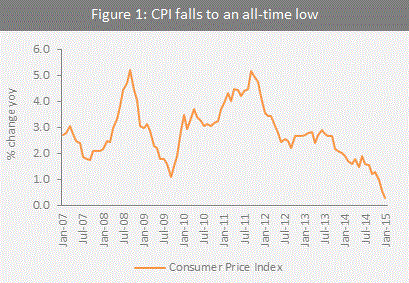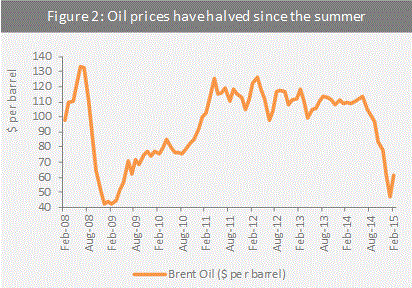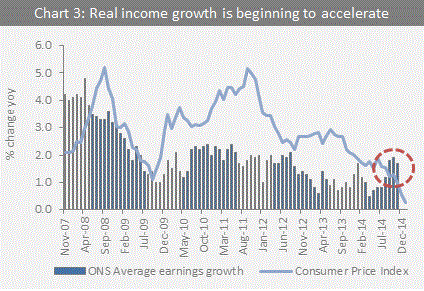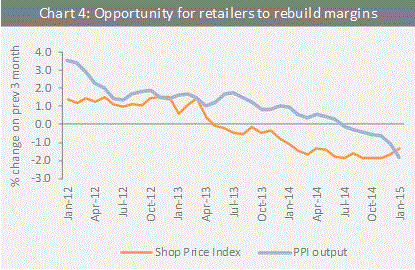Inflation falls to an all-time low. Are retailers rebuilding margins?
The Consumer Price Index (CPI) reached a record low of 0.3% in January, edging down from 0.5% reported in the previous month. We expect inflation to continue to fall through the first half of 2015 as the impact of weaker oil prices feed through the supply chain. We now believe that a brief period of deflation will, more likely than not, occur in March or April.

Source: ONSThe Bank of England’s latest report suggests that the inflation target of 2% will not be hit until 2017. However, Mark Carney, Governor of the Bank of England, said that he would “look through” the immediate effect of the fall in oil prices to broader economic forces like wages and productivity when contemplating a rise in interest rates.

Source: Bank of EnglandAnd in a departure from previous policy options, Carney made it clear that he would be willing to cut rates further should deflation show signs of becoming entrenched. However, given the strong economic outlook, we don’t believe this to be a likely policy option. In fact, Carney said it was “pretty clear” the next move would be a rate rise. The question remains, when?But “deflation” is the word of the moment and January’s CPI of 0.3%, shows that inflation is on the verge of turning negative. We believe the risk of deflation becoming entrenched is low given that many of the factors are temporary and one-off in nature. The impact of these temporary factors will diminish over the course of the year leaving inflation to edge back up. Indeed, core inflation, which excludes food and energy which are typically the more volatile components, ticked up to 1.4% in January from 1.2% in December. This is a more accurate reflection of domestically generated demand-pull inflation and supports the view that this latest set of data is unlikely to alter the Bank of England’s view on the timing of a rate rise. The markets were unmoved, still pricing in the first rate rise in the first quarter of 2016. Importantly, wage rises do not appear to be tailing-off and the latest IDS settlement figures show that median pay has picked up to around 2.5%. It would be a concern if businesses saw a period of deflation as an opportunity to award lower pay increases, however, after five years’ of persistent low wage rises, we do not believe this to be the most likely outcome. Indeed, the Bank of England’s forecasts suggest wages could be rising at a rate of 3.5% by the end of 2015.

Source: ONSFrom a retail perspective, a period of deflation in the wider economy could be a “good thing” provided it doesn’t become engrained. Deflation in areas such as transport and energy costs, which are relatively price insensitive, will boost household disposable incomes at a time when nominal wage growth is already accelerating. Providing households do not decide to increase levels of saving by the same amount, consumer spending will rise. While the grocery sector is facing its own set of unique challenges, the non-food sector is likely to benefit from this boost in household spending power. Sectors which are particularly income sensitive, such as consumer electricals and home, are likely to see the largest benefits. Deflation in the retail sector is nothing new. According to the latest BRC-Nielsen Shop Price Index (SPI), retail prices have been deflationary for 21 consecutive months driven by falling prices in electricals and clothing and footwear. However, the deflationary environment is changing. Shop price deflation throughout 2013 and 2014 was generally at the expense of margins, this compression appears to be easing in the short-term which could allow retailers to rebuild margins. In effect, the cost of goods faced by retailers is falling at a faster rate than the cost of goods faced by consumers.

Source: ONS, BRC-NielsenThe latest figures from the ONS suggest that Producer Prices (output), indicative of the costs faced by retailers, have been deflationary for seven consecutive months, down 1.8% in January. Input prices fell at their fastest rate since 2009. As the gap narrows between deflation faced by customers and the costs retailers face, margins can be rebuilt. However, rising labour and property costs are likely to offset some of these benefits so we do not believe this period will be long lived.
Back to Retail Economic News